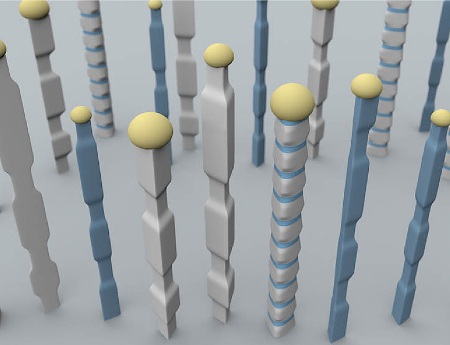A research team led by Silvija Gradeèak from the Massachusetts Institute of Technology has developed a novel technique capable of accurately controlling the composition, profiles and width of nanowires during their growth.
 Nanowires fabricated using the new techniques developed by Gradeèak and her team can have varying widths, profiles, and composition along their lengths, as illustrated here, where different colors are used to indicate compositional variations. (Image courtesy of the Gradeèak laboratory)
Nanowires fabricated using the new techniques developed by Gradeèak and her team can have varying widths, profiles, and composition along their lengths, as illustrated here, where different colors are used to indicate compositional variations. (Image courtesy of the Gradeèak laboratory)
This innovative technology paves the way to grow optimally designed complex structures for specific applications. The study findings are reported in the journal Nano Letters.
Metal nanoparticles or ‘seed’ particles used in growing nanowires determine the composition and size of the nanowires. In the process, the research team controlled the seed particles’ size and composition by altering the amount of gases utilized in growing the nanowires, which in turn controlled the size and composition of the nanowires.
The research team used indium gallium nitride and indium nitride for the nanowire-growth experiments. According to the team, the same process can be applied to other materials. The team used an electron microscope for studying the nanowires. It used its experience in growth patterns to make changes to the growth process. It reconstructed the three-dimensional form of single nanowires using electron tomography. It also utilized cathodoluminescence, a novel electron-microscopy technique, to study the types of wavelengths of light emitted from various regions of single nanowires.
According to Gradeèak, accurately structured nanowires are useful in developing a new class of semiconductor devices with superior functionality when compared to traditional thin-film devices fabricated from the same materials.
This novel process can be used to produce cost-efficient substrate materials, which represent a major portion of the cost of LED devices. The nanowires synthesized by this method are capable of forming zero-defect single crystals, which are useful in producing high-efficiency solar cells at a lower cost. Complex structures fabricated from nanowires with different diameters are ideal for developing novel thermoelectric devices that can generate electricity by harvesting waste heat.